

TV Comic
Doctor Who first transferred from television to comics on November 14th 1964, just under a year after its TV debut, when the first Doctor materialized his TARDIS in the pages of TV Comic #674, illustrated by Neville Main (the writer is unknown). This version of The Doctor, though, bore scant resemblance to the curmudgeonly scientist played by William Hartnell on TV. He may have looked vaguely like Hartnell, but he was more of a benevolent magician than a scientist, complete with a magic bag which held something for every occasion. He and his rather annoying 'grandchildren', John and Gillian, inhabited a whimsical fantasy world populated not by the Daleks and the alien Voord (TV Comic didn't have the rights to them), but by the likes of the Trods of Trodos (robots who were Daleks by any other name but not as threatening), the Kleptons and the ludicrous, wheeled 'Go-Rays', all aimed firmly at younger readers.
When Main left the strip to draw the slightly less silly adventures of Steed and Mrs Peel in The Avengers, Bill Mevin took over, but the strip stayed firmly in the nursery, with the Doctor on one occasion even helping out Father Christmas.
Early in 1966 the Doctor also made his American comics début — sort of — in a Dell Comics adaptation of the 1965 movie Doctor Who & the Daleks, a big screen adaptation of the first televised Dalek story. This version of the character, though, was the human scientist Dr. Who, a distinctly different character from The Doctor. The comic would eventually be reprinted in Britain decades later by Marvel UK as Doctor Who Special #26.







Doctor Who by John Canning

In 1966, Patrick Troughton took over the role on TV, and John Canning took over the strip illustration duties, bringing a new depth to the strip and becoming unquestionably the definitive illustrator of the second Doctor. The strip still didn't really resemble its TV counterpart, but some of the more outre fantasy elements were phased out, as were John and Gillian (who went off to university on the improbably named planet of Zebadee), replaced now by television companion Jamie McCrimmon. TV Comic also negotiated for the rights to a couple of the television show's villains, including the Quarks (minus their Dominator overlords), the new TV sensation that were the Cybermen, and most significantly the Daleks themselves (who, in a rather nice twist, promptly exterminated those mickey taking Trods). The strip was for a time renamed 'Dr Who & the Daleks', even when the Daleks weren't actually appearing in it, TV Comic evidently figuring that cashing in on the metal meanies' popularity couldn't hurt (the Daleks had already proved their worth in a long running solo strip in rival publication TV Century 21). But the most wildly imaginative second Doctor story was without a doubt the final one: on TV, Patrick Troughton had departed the role, but with several months' break between seasons, his successor was not yet known, so the strip took a few liberties with the ending of Troughton's last TV story (in which the Doctor was exiled to Earth with a new face by his own people, the Time Lords) by explaining that, while the exile had indeed begun, part two of his sentence hadn't yet been instigated! Instead, for several months, the still unregenerated second Doctor lived in an hotel in London, investigating sinister occurrences, until finally an investigation into walking scarecrows had him dragged off by the straw men - really agents of the Time Lords - to have his appearance altered prior to the third Doctor's television debut!
Countdown to TV Action

Canning continued to draw the strip after the arrival of the third Doctor (played on screen by Jon Pertwee) in 1970, and elements from the TV series (such as Brigadier Lethbridge Stewart) continued to appear, but change was in the wind. In 1971, Polystyle launched a new, high quality (and high price) comic called Countdown, aimed at a slightly older readership than TV Comic and primarily based on Gerry Anderson's puppet series' including Thunderbirds and Captain Scarlet. This new title (later to become 'Countdown for TV Action', 'TV Action incorporating Countdown', 'TV Action & Countdown' and finally just 'TV Action') was a far more natural home for Doctor Who than TV Comic, and it consequently jumped ship, the Doctor becoming one of Countdown's new stars. The strip was now written by Dennis Hooper and illustrated first by Harry Lindfield, then Frank Langford and ultimately Gerry Haylock, all of whom turned in some terrific work; Doctor Who was now a hard edged thriller series with the Doctor living in a house in the English countryside and investigating alien incursions and mad scientists for the Government, all of it beautifully illustrated in glorious full colour. Haylock became the definitive third Doctor artist, and his work has never really been bettered. Gradually, too, elements from the TV series began to creep in, notably the Doctor's arch foe The Master, as well as the Time Lords and, of course, the Daleks. Unfortunately, beautiful though these strips were, they were expensive to produce, and that led to TV Action pricing itself out of the market. It was cancelled in 1973 and Doctor Who returned to the pages of TV Comic with issue #1204, ushering in a new era with a new (fourth) Doctor, as played by Tom Baker, complete with television companion Sarah Jane Smith.

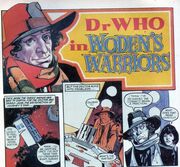
Return to TV Comic
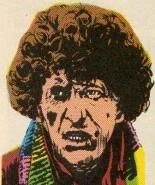
Gerry Haylock left the strip following the new Doctor's first strip, to be replaced by Martin Asbury, who gave the readers two beautifully drawn strips (in one of which the Time Lords' planet of Gallifrey was inexplicably renamed 'Jewel'). Unfortunately, Asbury then moved on to draw Garth for The Daily Mirror, and the Doctor Who strip was left without an artist. TV Comic's editors promptly ordered old standby John Canning to step into the breach, but these later strips lacked the polish of Canning's original work, even with the addition of new TV companion Leela (forced to swap her skimpy animal skins for jeans in this juvenile orientated publication). From #1385, no new Who strips were printed in TV Comic; instead, readers were given reprinted second Doctor strips with Troughton's head redrawn as Tom Baker's and a scarf added!

It was ridiculous, and it was doomed. Doctor Who finally departed from TV Comic's pages on 12th May 1979.
Doctor Who Weekly

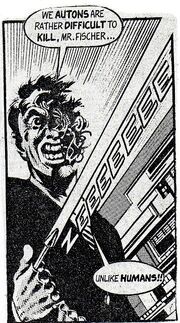
Art from Business as Usual by David Lloyd
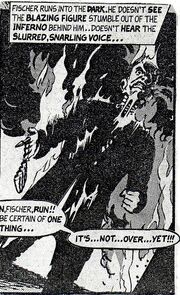
The Doctor's absence from comics wasn't a long one though: five months later on October 17th, Marvel UK under the guidance of editor Dez Skinn launched Doctor Who Weekly, and writer Pat Mills and artist Dave Gibbons' boggle eyed fourth Doctor, rendered not so much in the mighty Marvel manner as in a manner all his own, was an instant hit with readers. Marvel were initially unable to use the Doctor's TV companions (with the exception of K9), so instead created their own, beginning with schoolgirl Sharon Davies, as well as providing the Doctor with a plethora of new villains including the demonic Malevilus, the Time Witch Brimo and Beep the Meep. They also ran backup strips featuring various monsters from the TV series, alongside new, originated characters such as Abslom Daak, Dalek Killer, Kroton the Cyberman and the Special Executive (the latter of whom would later go on to enter the Marvel Universe proper as supporting characters in Captain Britain). One of the best remembered of these strips was Alan Moore's wonderfully creepy 'Business as Usual', featuring the Autons.
Doctor Who Magazine and US Reprint Titles



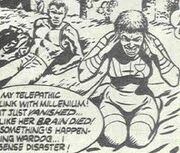
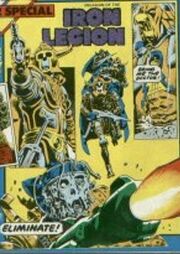

The American Marvel Doctor Who title
After 43 issues, Doctor Who Weekly became a monthly magazine, titled 'Doctor Who: A Marvel Monthly' (later, it would become first 'Doctor Who Monthly' and then 'Doctor Who Magazine'). More pages were added, and some of the comic content (namely the centre strip, non Doctor Who related US Marvel reprints of classic sci-fi stories such as The Invisible Man) was dropped in favour of articles about the TV show; readers preferred the magazine approach, though the strips remained an integral part of the mag, with reprints of the classic Daleks strip from TV Century 21 becoming a regular feature for awhile. With the departure of Mills and Wagner from the writing duties, the strip was turned over to Steve Parkhouse, who ushered in the era of the fifth Doctor (now played on TV by Peter Davison) with the epic adventure 'The Tides of Time', a bizarre but compelling tale which also gave the Doctor a recurring ally in the shadow man Shayde and briefly, a new companion in the doomed knight Sir Justin. It was a wonderful mix of sci-fi and Arthurian myth and remains one of the best remembered Doctor Who strips to this day.


The sixth Doctor and Frobisher
Dave Gibbons left the strip shortly afterward, and a succession of artists have worked on it since. Most of these early Marvel strips were eventually reprinted in the US in full colour; the first two (The Iron Legion and City of the Damned) in issues #57-60 of showcase title Marvel Premiere in 1981, 'The Spider God' as a backup strip in the 1982 Starlord Special Edition, and then all of the other lead strips and many of the backups in 23 issues of an American Doctor Who title which ran from October 1984 to August 1986, ending with the final fifth Doctor strip. Alan Moore's Special Executive stories were omitted, however, since Moore had refused Marvel permission to reprint them following a falling out with the company. The Sixth Doctor's era (actor Colin Baker having taken over from Davison on TV in 1984) brought in an enduring new character in the Doctor's new companion Frobisher, a shape shifting alien private detective who contracted a rare disease which left him stuck in the shape of a penguin! Insane though that sounds, it fitted perfectly with the often rather surreal stories being told, now with art by the likes of John Ridgway. Frobisher, like Abslom Daak and Beep the Meep before him, was so popular he even transcended the comic strip itself and made it into Doctor Who stories in other mediums; in 1994, by then former Doctor Colin Baker himself (evidently a fan) included Frobisher in 'The Age of Chaos', a one off Doctor Who comics special which he wrote for Marvel! Television companion Peri Brown was also brought in for a time. In 1984, two of the sixth Doctor stories were reprinted in colour in a Doctor Who Collected Comics Special.

Other Marvel UK Titles
Though the Doctor Who TV series ended its original 26 year run in 1989, both Doctor Who Magazine and the regular Doctor Who Specials just kept on going, with the seventh Doctor (as played by Sylvester McCoy) having far more adventures in strip form than he ever had on screen, both in DWM and in juvenile publications like The Incredible Hulk Presents and the Marvel Bumper Comic (some of which were reprinted later in DWM itself despite being aimed at a much younger age group). In the early nineties, Marvel also took the unusual decision to begin linking the continuity of the strips in with that being established in the Virgin Books series of Doctor Who New Adventures novels, bringing in companions Ace and Bernice Summerfield and arguably thoroughly confusing people who didn't read the books: by this time, Doctor Who stories were being written primarily for the hardcore fans though, so this wasn't really an issue. This all ended, though, with the cancellation of the New Adventures range when Doctor Who returned as a TV Movie starring Paul McGann as the eighth Doctor in 1996. Marvel effectively separated the comics continuity from that of the books again by killing off Ace, in a manner totally at odds with her departure in the novels. Marvel also published a companion title to DWM during this time, Doctor Who Classic Comics, which reprinted not only the early Marvel strips but also the Polystyle and TV Publications ones from TV Comic and Countdown/TV Action. It ran for 27 issues and one special, from December 1992 to December 1994.
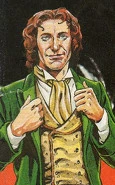
DWM Becomes a Panini Publication
In the 1990s, with Marvel US in financial trouble, Marvel UK was sold off to Panini, who continued to publish titles under the Marvel UK title under licence (and still do). The Marvel UK banner was eventually removed from Doctor Who Magazine after December 1999, but the magazine itself continued as a Panini publication, the eighth Doctor notching up an impressive eight years' worth of strip adventures on the back of his solitary TV appearance (paradoxically, counting books, comics and audio adventures, the eighth Doctor-who had less screen time than any other-is actually one of the longest running-he even had his own strip in The Radio Times in 1996!). Panini also plundered the magazine's own past, bringing back Kroton the Cyberman as a companion, as well as resurrecting Shayde. The strip was possibly at its most adult at this time, aimed squarely at the longtime fans and written primarily by Scott Gray. But this would all change in 2005 when Doctor Who returned to television once more.
TV Revival and New Titles

Art from IDW's US published Doctor Who title, by Andrew Currie


The arrival of the revived TV series (and the ninth Doctor, played by Christopher Eccleston) brought with it a massive influx of new readers for Doctor Who Magazine, which consequently underwent a major revamp-though the strip continued to be a prominent feature. As the tenth Doctor's tenure arrived, the strip became often rather more cartoonish (actor David Tennant having a lot of younger fans) and the BBC themselves got in on the act too, with Doctor Who Adventures, a comic aimed firmly at the juvenile market, and later Doctor Who-Battles in Time (aimed at gamers) and a Torchwood Magazine based on the popular spin-off series Torchwood, which also carried a comic strip. The Doctor's strip adventures have also crossed the Atlantic once more, with independent US publishers IDW winning the licence to both reprint the old Marvel UK strips based on the classic series Doctors and publish new, original material based on the new series Doctors (since then, this licence has been taken over by Titan Comics, who now publish their own US format Doctor Who titles as well as, briefly, the magazine format Doctor Who Comic). And of course, the revival of the Doctor Who TV series also brought with it a revival of the long running Doctor Who Annuals (originally published by World Distributors from 1965-1986, then by Marvel UK as 'yearbooks' from 1991-1996, by Panini in 2005, and now published by BBC Books since 2006), which have almost always carried strips alongside their text stories, and often beautifully drawn ones at that.
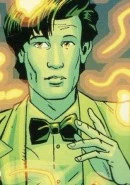
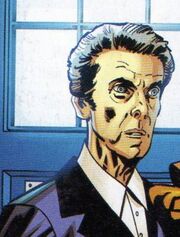
DWM is still published to this day, and the comic strips now feature the thirteenth Doctor, as portrayed on screen by Jodie Whittaker.
The Doctor Who comic strip has now been running in one form or another and under one publisher or another for over 50 years, and thanks to the TV series' 16 year hiatus between 1989 and 2005, has now actually been running continuously for longer than the show on which it was based! The Doctor has also guest starred in numerous other comic strips, from Marvel UK's Death's Head to The Sun's Millie, and has even teamed up with the characters from Star Trek in one limited series, a British institution who has become a genuine global phenomenon.
- See Also:
